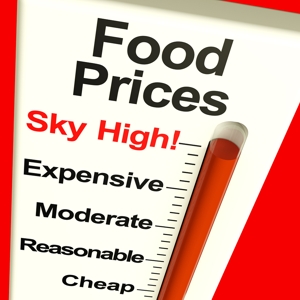The official Canada Food Price Report (FPR) for 2021 is out, and the forecast is for cloudy skies and more-expensive food, regardless of what your lifestyle or preferences may be. Brace yourself for something like an average increase next year of at least 5 percent…
 While the 2021 FPR gives it only a cursory mention, for those who rely on food
While the 2021 FPR gives it only a cursory mention, for those who rely on food
delivery services, the relatively high fees charged by such middle-men can
increase the cost of eating for the convenience-addicted significantly…
The annual FPR is really not a report but a forecast, compiled by the Ag Canada experts at the University of Guelph and Dalhousie University, Canada’s premiere Agricultural research institutions. This year, the picture has been bolstered by on-the-spot contributions from out west by the University of Saskatchewan and the University of British Columbia. And the news is not good, particularly on top of a similar increase last year, and with the shadow of COVID-19 and its economic privations hanging over the land.
The overall outlook…
The experts say to expect an overall average food price increase of 3 to 5 percent. But brace yourself for specific jumps in meat by 4.5 to 6.5 percent for meat, 3.5 to 5. percent for Bakery and 4.5 to 6.5 percent for veggies. Based on added details provided by the new contributors to the database, the 2021 FPR is providing more-detailed results, right down to the age and gender of individual consumers. For example, “Based on a family including a man (age 31-50), woman (age 31-50), boy (age 14-18) and girl (age 9-13), the annual family food expenditure is predicted to be $13,907 in 2021, an increase of up to $695 (5 percent).”
“Families with less means will be significantly challenged in 2021, and many will be left behind,” says Dr. Sylvain Charlebois, Project Lead and Director of the Agri-Food Analytics Lab at Dalhousie University. “Immunity to higher food prices requires more cooking, more discipline and more research. It’s as simple as that.”
Is the increase – at a time when most folks haven’t had a regular pay cheque for almost a year due to the pandemic social and economic lock downs entirely attributable to the coronavirus crisis? Or are there other causal factors we should be aware of? Apparently not.
“The COVID-19 pandemic led to border and facility closures, shifting consumer demand and unemployment, as well as modifications in production, manufacturing, distribution and retailing practices to enhance safety — all of which impacted food prices. An oil price war and the devaluation of the Canadian dollar were also significant factors.”
The Veggie Factor…
Project Co-lead Dr. Simon Somogy was most surprised by the increase in the price of vegetables and has some advice for consumers:
“Health Canada wants us to eat more vegetables and that’s going to be harder. Hopefully, when the Canadian growing season comes online in summer 2021, prices will soften and more families will have access.
“When folks go to the grocery store, they should have a look in the frozen food aisle, particularly for peas, broccoli, carrots and corn. Frozen vegetables are snap frozen just after harvest, so their nutrients are locked in. They can be just as nutritious as fresh vegetables, but at a lower price.”
The takeaway…
As we’ve seen in 2020, food prices in Canada may suffer notable increases. But there should be no serious shortages, especially of foods that the recently-updated Canada’s Food Guide says we should be eating more of: Fresh Fruits and Veggies, and Whole Grain Products. Canadians, the 2021 forecast concludes, should not have to worry about any significant eruptions of hoarding of any basic food or household products over the next 12 months.
My take…
Though the 2021 Food Price Report gives the issue of shortages and hoarding only a brief, cursory comment, I think the prediction that, “Canadians can be confident in their food supply,” is just as important as the price increase forecast.
And, on the down side, dare I mention that another factor is placing upward pressure on food prices, literally at consumer’s doorsteps’? Using services such as UBER Eats, Skip The Dishes and Door Dash adds a steep (percentage-based) fee to the bottom line on meals ordered for delivery.
The best news is, there are things we can all do to mitigate the impact of both those factors on our diet and overall health picture.
Now, if only there was a national Mental Health Forecast, that would be a real gripper of a read…
~ Maggie J.

